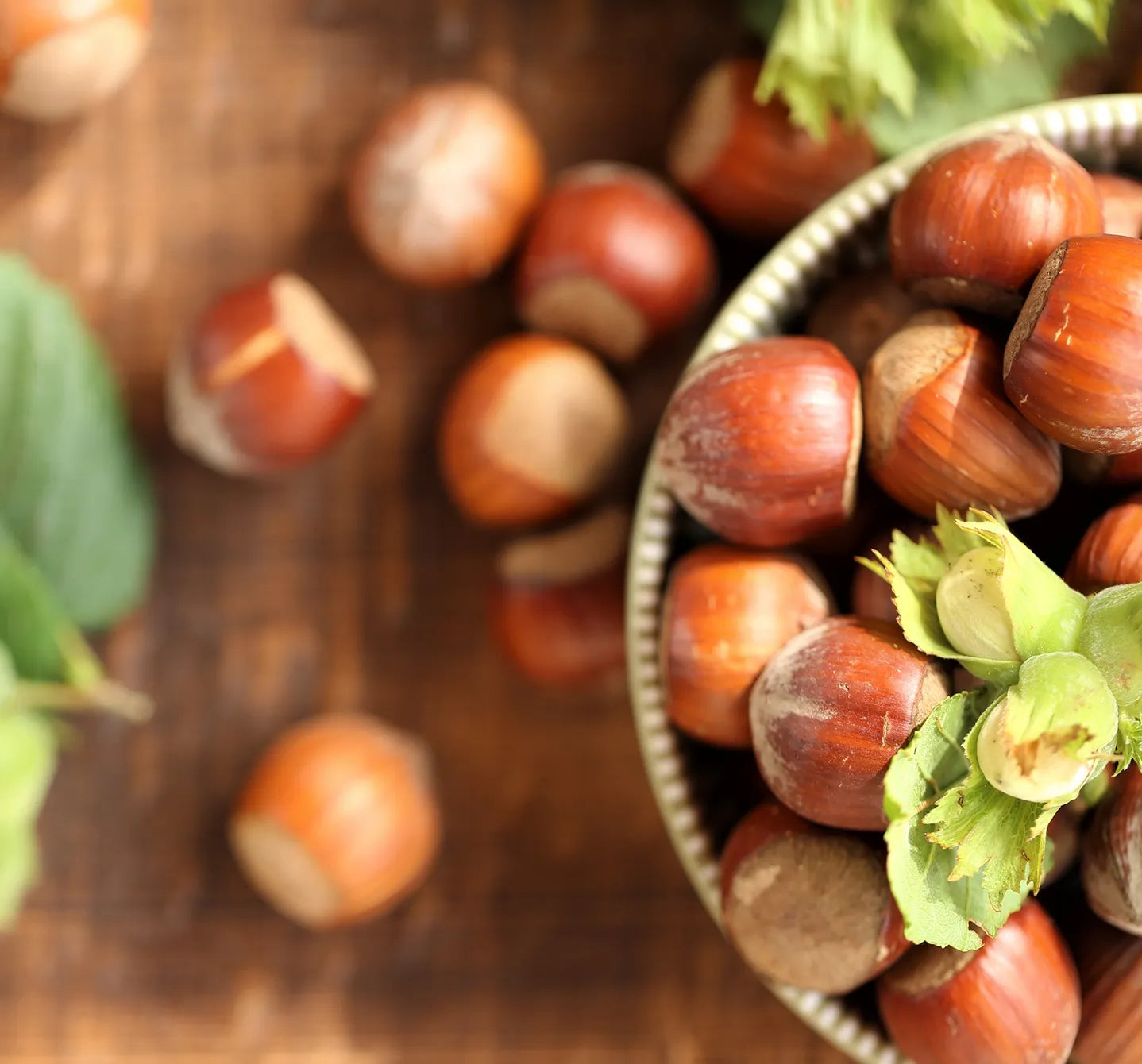What is Hazelnut allergy?

Hazelnut is one of the nuts commonly linked to allergic reactions. You may have a hazelnut allergy or it could be a cross-reaction. That’s when another substance is so like your trigger it can give you symptoms. People allergic to birch pollen can get an itchy mouth from eating hazelnuts.
Any symptoms from hazelnut, however mild, are a signal to talk your healthcare provider right away. Food allergies carry the risk of anaphylaxis. This is a severe systemic allergic reaction (that means it affects your whole body). Anaphylaxis can be life-threatening and is a medical emergency.
Read on to find out more about:
- What’s going on inside your body when you have hazelnut allergy
- Signs and symptoms to look out for
- How to get a diagnosis
- Tips for managing the condition
- Some treatment options
Is hazelnut a nut allergy?
Yes, it is. People often say nut allergy when they talk about reactions to peanuts and tree nuts. These are two different types of food. Peanuts don’t grow on trees. They’re a legume, like peas and beans. And they have a separate mention in the list of major allergens (substances that can cause allergy) covered by food labeling laws.
Other than hazelnut, common causes of tree nut allergy include almonds, Brazil nuts, cashews, macadamia nuts, pecans, pistachios and walnuts. If you’re allergic to any of these, look out for “tree nuts” in the ingredients.
Why hazelnut allergy happens
Your immune system decides harmless hazelnut is a threat and reacts just as it would to a parasite, bacteria or virus. It produces immunoglobulin E (IgE) antibodies to keep watch for that substance or allergen. There are six proteins in hazelnut known to cause allergic reactions. You may be allergic to one or more of them.

Ever get hay fever from birch? Then hazelnuts could give you allergy symptoms too. If so, it could be oral allergy syndrome. Hazelnut allergy rates seem higher where birch grows.
This first step is called sensitization. You won’t usually have an allergic reaction until your next contact with hazelnut. And possibly not even then. Not everyone who’s sensitized goes on to develop an allergy. If you do, the IgE antibodies will tell cells to release histamine and other chemicals to get rid of the intruder. And that causes your allergy symptoms.
Hazelnut allergy vs cross-reactivity
Do you get hay fever from birch pollen allergy? Then eating hazelnuts could give you mild local allergy symptoms, particularly in the spring when birch flowers. This cross-reaction is called oral allergy syndrome (OAS) or pollen food syndrome (PFS). It happens because the pollen and nut share similar proteins which confuses your immune system even more. OAS may be the reason hazelnut allergy rates seem to be higher in places where a lot of birch trees grow.
Adults are more likely than children to be sensitized to one of the hazelnut proteins linked to oral allergy syndrome (OAS).
Symptoms may include an itchy puffy mouth, lips, tongue, throat or face. Some people get a rash on their mouth and itchy ears. The risk of systemic reactions is lower than with a food allergy. But get a check-up as soon as possible in case that’s what it is.
What does hazelnut allergy feel like?
Food allergy symptoms can be quite uncomfortable. Here are some of these signs you could be having a mild to moderate allergic reaction to hazelnuts:
- A raised, itchy red rash (hives) – sometimes the skin can turn red and itchy but not raised
- Tingling or itching in the mouth
- Swelling of the face, mouth, throat or other parts of the body
- Difficulty swallowing
- Wheezing or shortness of breath
- Feeling dizzy and lightheaded
- Feeling sick (nausea) or vomiting
- Abdominal pain or diarrhea

Food allergy
symptoms explained
It can start seconds or minutes after contact with the allergen. Usually you'd expect to feel something within two hours.
Hazelnut allergy and anaphylaxis
Both raw and cooked hazelnuts are capable of causing anaphylactic reactions within minutes or up to a few hours later. This is a medical emergency which needs immediate treatment. So get help quickly if you spot any of these symptoms:
- Skin reactions, including hives all over your body, itching and flushed or pale skin
- Low blood pressure (hypotension)
- Constriction of your airways and a swollen tongue or throat, which may cause wheezing and trouble breathing
- A weak and rapid pulse
- Nausea, vomiting or diarrhea
- Dizziness or fainting
Feeling stressed or unwell can make an allergic reaction to hazelnuts more likely to be severe. So can some medication or exercising just before or after eating. Also, the risk of anaphylaxis happening in the future rises after you’ve had it the first time.
When does hazelnut allergy start?
You can develop a tree nut allergy like hazelnut as an adult. It’s more common, though, for reactions to start in childhood, usually after the age of one (unlike peanut allergy which can appear as early as six months old). The risk is greater if your father, mother, brother or sister has hazelnut allergy. That’s why your healthcare provider will ask about your family’s medical history as well as your own. Having an egg allergy or an allergic condition like severe eczema also makes it more likely.
Children are also more likely than adults to have severe allergic reactions to hazelnut affecting their whole body.
Allergy medicines
for kids

Hazelnut allergy tests
Diagnosing tree nut allergies can be complex and you may need to have more than one type of test. Your healthcare provider or allergist may also suggest testing for several nuts. Being allergic to one tree nut makes it more likely you’ll react to another. Hazelnut and walnut have similar proteins. And up to 40% of kids with peanut allergies also react to tree nuts.
This is usually the first test you’ll have. The allergist or allergy nurse puts drops of liquid containing different allergens onto your skin and pricks it gently. An itchy bump may appear within the next 15-20 minutes.
If the skin prick test is inconclusive, you may have an allergy blood test. This looks for IgE antibodies. It can show if you’re sensitized to an allergen like hazelnut and could be allergic.
A component blood test is more detailed. It checks your sensitization to specific proteins. Some are more likely than others to trigger severe allergic reactions affecting your whole body. Scientists have identified three in hazelnuts so the test can help your healthcare provider assess the risk to you.
One of these proteins is type called a lipid transfer protein (LTP). These are found in the skin, pips and seeds of many plant-based foods. Adults can develop lipid protein transfer allergy and react to several fruit, vegetables, nuts and cereals.
Component blood tests can also look for proteins linked to OAS.
Oral food challenge
Kids are less likely to grow out of tree nut allergies like hazelnut than some other early food allergies. If it seems they may have, then an oral food challenge can help to confirm it. This involves eating the allergen, starting with a tiny amount and gradually increasing. Oral food challenges happen at the allergy clinic while medical staff monitor you, ready to treat any allergic reaction.

Managing hazelnut allergy
There is no cure for hazelnut allergy. Your healthcare provider or allergist will work out a treatment plan with you. This is likely to be a mixture of avoiding your triggers completely and treating the symptoms when you haven’t been able to. As with any IgE-mediated food allergy, managing your condition will become part of everyday life.
What foods to avoid if you have hazelnut allergy
Food manufacturers, restaurants, cafes and delis all have to highlight tree nuts in the ingredients. Here are a few of the more common places where you might find them:
- First meal of the day: breakfast cereals, chocolate hazelnut spread
- Coffee break and tea-time: cookies, cakes, pastries, hazelnut milk
- Any-time treats: chocolate bars and filled chocolates, ice creams
- Condiments and ingredients: Hazelnut oil
Body care products using hazelnut oil may be best avoided too. The refining process changes the proteins which makes allergic reactions less likely. But cold-pressing does not. Something else to ask your healthcare provider about.
Can you be allergic to hazelnut flavor?
Hazelnut flavor comes largely from a chemical called filbertone. (Filbert is another name for hazelnut). Flavorings may not be made from the real ingredient like a nut or fruit. Food companies recreate them too. In which case, they must be labeled "artificial". But take nothing for granted. Read the ingredients very carefully and call the manufacturer if you’re not sure whether a food contains hazelnut allergens or not.
That’s also the best approach if you can’t do without a hazelnut latte in the morning or a slow hazelnut Frappuccino at the weekend. Flavored coffee beans and hazelnut syrup may or may not be made with hazelnut.
A simple guide to
peanut allergy

Hazelnut allergy: Reducing the risk of accidental exposure
Even the tiniest amount of hazelnut could give you an allergic reaction. That’s why cross-contamination can be a problem. Traces linger, get picked up and are carried to unexpected places. That’s why you see “may contain nuts” and variations of this message on food packaging. But it also happens in the kitchen.
Be careful how you prepare, serve and store food if you cook with hazelnuts, and how you clean up afterwards. And talk to anyone who’s going to feed you about your hazelnut allergy. That could be friends and family, the restaurant you’ve been invited to, cafes, the local ice-cream parlor or the airline taking you on holiday. And make sure you know the local words for tree nut and hazelnut wherever you’re going.
Symptom relievers and emergency treatment for hazelnut allergy
Sometimes, despite your best efforts to avoid hazelnuts, you will have an allergic reaction. Antihistamines may help relieve mild symptoms but they are not an effective treatment for anaphylaxis.
Emergency treatment for hazelnut allergy is epinephrine, which is another name for the hormone adrenaline. That’s what the paramedics will give you if you spot the symptoms of anaphylaxis and call an ambulance, which you must do right away. Tell them if you’re already on medication. Some types, for instance B-blockers or ACE-inhibitors, can make epinephrine less effective.
Once you have your diagnosis your healthcare provider may also prescribe epinephrine for you to self-administer via an auto-injector. It’s a good idea to carry two auto-injectors at all times in case one doesn’t work or isn’t enough to stop the anaphylactic reaction. You should always go to hospital even if the injection makes you feel better. There can be a second wave of delayed symptoms some hours later.
Summary
Hazelnut can cause a mild to life-threatening allergic reaction. Call 911 if you have breathing difficulties or feel dizzy. This could be anaphylaxis. You must avoid hazelnut and may have to carry emergency medication. If hazelnuts make your mouth itch in spring, it could be related to birch pollen allergy.
Last medically reviewed on September 13th 2022

 Find A Doctor
Find A Doctor